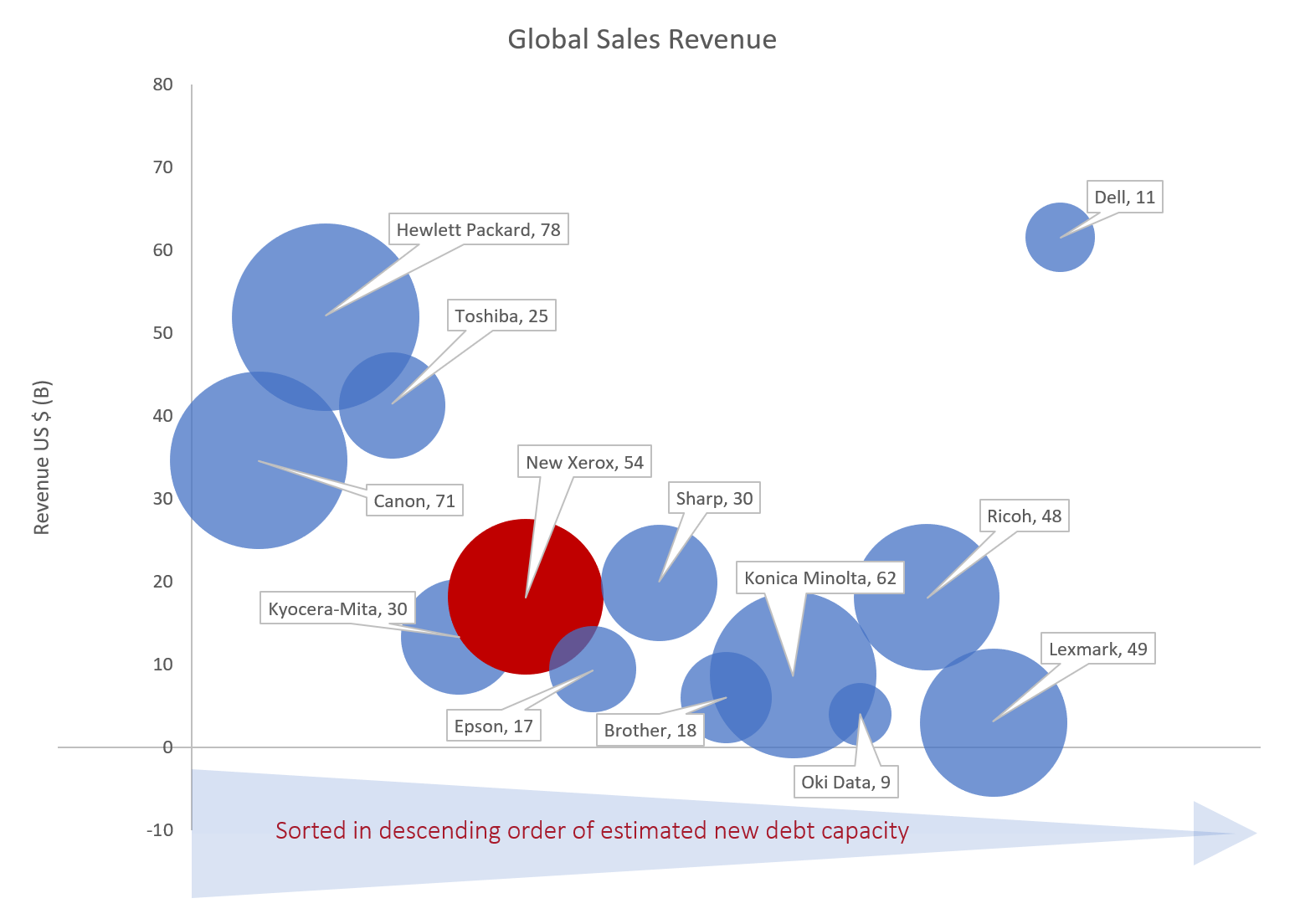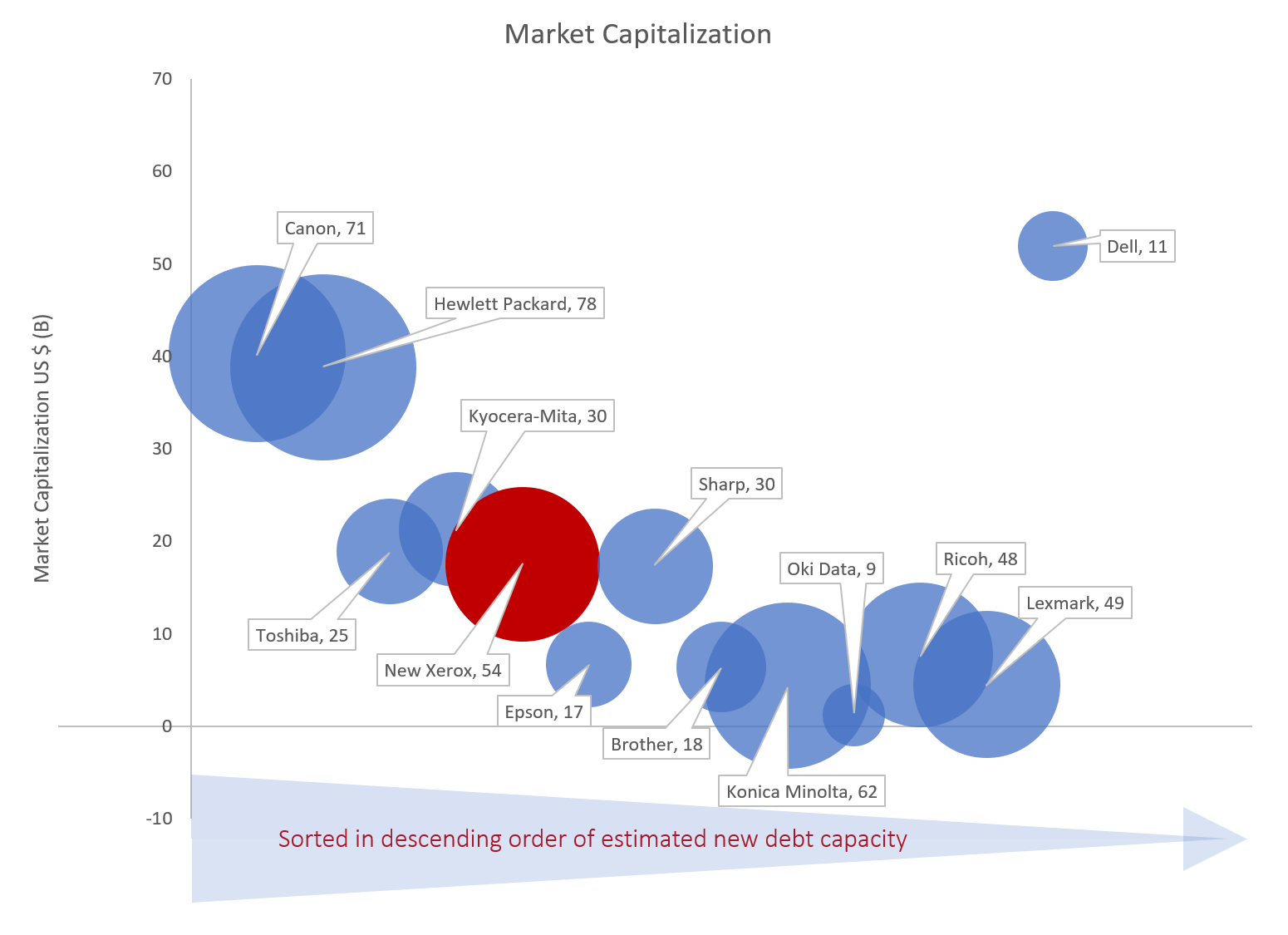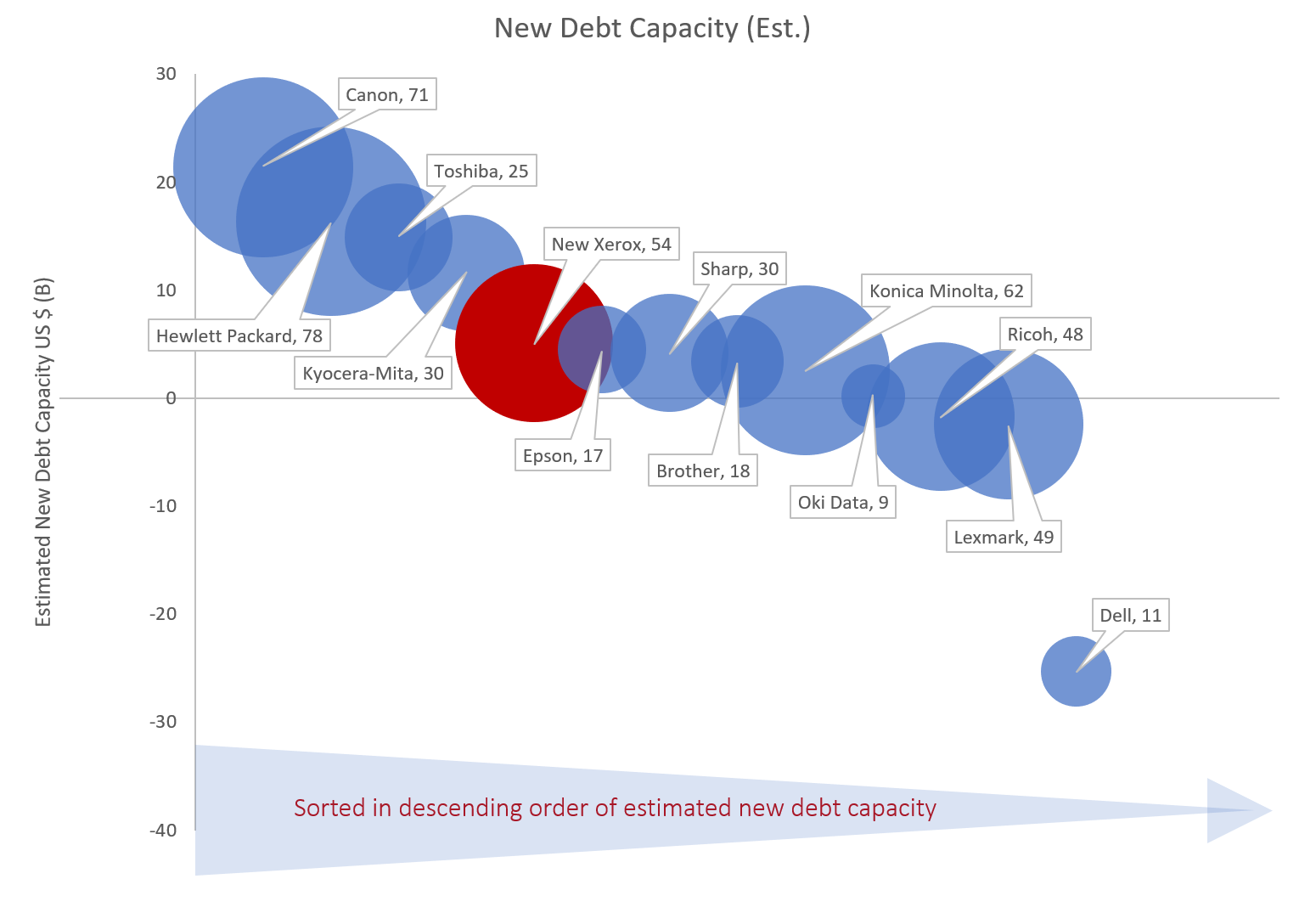We think it's fair to speculate that most observers outside of Xerox (maybe many insides) are also skeptical that the proposed business combination with Fuji Xerox will likely make a difference. We previously formulated the argument that the new Xerox must increase revenues at 5% per year to have a chance of supporting an ongoing 13X multiple on its share price. Xerox must win more than $3.5B of new business over the next four years to satisfy investors.
- Part I - Will the Fuji Xerox acquisition of Xerox make a difference?
- Part II - Where's the upside in the Fujifilm deal to combine Fuji Xerox and Xerox?
- Part III - Who, if anyone, is vulnerable to losing market share to the new Xerox?
We're motivated to close out our three-part series with an objective assessment of the marketplace players and their financial strength and to place this alongside a subjective evaluation of their capabilities. We aim to see if any compelling, non-obvious upsides emerge that could turn the skeptics on their heads and point us all toward an improved outlook for a beleaguered business.
Most of the content we're presenting here is based on the financial performance of each of the businesses Xerox competes with, their balance sheets, their respective product and service offerings, and their overall business strategies.
Our goal is to see if we can identify which (if any) of these competitors may be vulnerable to collectively giving up the $3.5B of business that Xerox needs to achieve reasonable financial goals.
First, our assumptions:
1. as we're traditionally inclined to define it, the market may decline at 5% or more per year, but the overall outlook should be considered differently. Although printed pages may decrease significantly, revenues generated from service-related offerings may compensate for the decline in print-related transactional revenue.
2. a sophisticated suite of hardware, supplies, and service-related offerings must be made available for a participant to succeed in the market.
- A comprehensive MFP hardware portfolio.
- Device ecosystem (hardware plus software and services).
- Channel-specific solutions - i.e., medical, legal, etc.
- Associated offerings for MPS, Managed IT, Managed Document Systems, Workflows, and Security.
- Current and historical standing in terms of market share.
3. We have referenced a February 2018 MarketScape analysis conducted by IDC to help understand the capabilities and strategies of the market's 13 primary participants. We use this report as an authoritative source to rank the market participants regarding their abilities and processes.
4. Certain, clearly identifiable factors contribute to making one company a stronger player than another. These factors include:
- Market share/revenues.
- Market capitalization.
- Debt capacity.
5. A transactional business proposition is far more easily attacked than a services-oriented business. For example, all the players in the A3 space have hardware and software-based ecosystems. Once a client is established on one of these ecosystems, it becomes painful for a change to take place. The larger a business - i.e., Canon, Xerox, etc., the more clients they have in its ecosystem. It becomes challenging for competitors to convert to an alternative ecosystem. Therefore, changes from one vendor to another are increasingly complex. Unless there's a significant breakthrough in technology that compensates for the pain involved, it becomes less likely for substantial changes in market share to occur.
The Numbers:
The following charts are presented to show the relative strength of the market participants in terms of their capabilities and strategy. The larger the bubble, the greater the power of the value proposition and vice versa. These business capabilities are then presented in three different forms on the vertical axis using three other measures of financial stability:
- Market share (sales revenue)
- Market capitalization (outstanding shares x share price)
- Debt and Debt Capacity
- Debt capacity is directly related to profitability because the more significant the debt capacity, the greater the underlying profits must be.
- Debt may be used to finance channel development (new products, new sales channels, acquisitions, etc.) if current cash flow (profits) are utilized elsewhere.
As a guideline for interpreting the charts, the larger the bubble, the closer it is to the vertical axis, and the higher the position it occupies on that vertical axis, the more robust the business and the better positioned it is to win market share.
Based on Global Sales Revenue:
There are three clusters:
- Hewlett Packard, Canon, and Toshiba
- Kyocera-Mita, The New Xerox, Sharp, and Epson
- Brother, Konica Minolta, Ricoh, Oki Data, and Lexmark
There is one outlier: Dell Technologies - the largest in terms of sales revenue and market capitalization but also the largest in debt and the weakest in terms of its value proposition necessary for success in the channel.

Based on Market Capitalization:
Once again, there are three clusters. The only significant change from the sales revenue chart is the movement of Toshiba from the first to the second cluster. This reflects the impact on their share price that has resulted from recent woes associated with their nuclear power plant business and the Westinghouse Electric bankruptcy.

Based on New Debt Capacity:
Debt may or may not be used to fund sales channel development, but debt capacity is a valuable indicator of the financial strength of a business. This, in turn, indicates how well a company may be positioned to compete for market share.
Although we don't see the same three clusters in this chart, it's still helpful to see the relative strength of the different market participants. For example, Toshiba has plenty of debt capacity, some of which could (in theory) be allocated to improve its value proposition (25) and its sales channel development. The same applies to Kyocera Mita (30) and Epson (17). Conversely, Konica Minolta (62), Ricoh (48), and Lexmark (49) may all be weaker in terms of debt capacity, but each of them already has relatively strong value propositions.

Market Dynamics
Hewlett Packard has announced its intention to enter the A3 space, where they're purported to currently have a 2-3% share of a $55B market. If they can win a 10% share by 2020 (even if the market's declining at 5% per year), it will be a $4.7B channel for them in 2020 compared to $1.4B today. This represents $3.4B of incremental sales that helps protect their top line from declines that may occur elsewhere (i.e., A4) in their business.
Remember, with Hewlett Packard's acquisition of Samsung's printer business, they are no longer shackled to Canon. They have complete control of product development and the value chain, and there's no longer any margin to share with Canon. This acquisition is likely to improve their competitive standing.
Combined with the possibilities for growth from the developing 3D industrial printing opportunity, it's not difficult to understand how HP is more likely to continue to grow its top line than most of its competitors.
Some skeptics doubt HP's ability to break into the A3 market. They may have a good reason for skepticism as the major players already have their customers embedded in their ecosystems, and (as we've already said) it takes a strong proposition and considerable time to persuade anyone to switch. However, despite this barrier, we can be sure that HP will compete vigorously for shares, leveraging its "best-in-class" value proposition and financial strength to attempt to achieve its objectives. Time will tell whether these attempts will be successful.
So, HP will attempt to win $3.4B in new market share, and Xerox needs to increase its sales by $3.5B. The two represent nearly $7B of market share shift - probably more than 15% of the projected US 2020 market! Based on the obstacles to converting a customer from one ecosystem to another, it isn't easy to believe a shift of this scale will occur.
Furthermore, it's not just HP that Xerox has to worry about. Look at the other players in the cluster surrounding them. Take Epson and Kyocera Mita, for example. Both are contenders, and neither has as strong a value proposition as Xerox, but they will continue to chip away to try and achieve their business objectives. As they do so, they'll probably erode some of Xerox's margins and maybe win a few customers here and there. Between them, there's plenty of cash available that could be used to fund channel development.
Then look at the third cluster where, although there's less cash available, there are some strong players in terms of their value propositions - particularly Konica Minolta, Lexmark, and Ricoh. Each of these will continue to work hard to build its market share.
The bottom line is that Xerox is surrounded by hungry competitors looking to increase market share just as they are. However, not everyone can increase market share simultaneously, and there don't appear to be any apparent avenues pointing to a Xerox advantage that will help them do so over the others.
The Xerox Dilemma
In March 2017, Xerox announced its most significant new product launch by introducing 29 ConnectKey® enabled printers and multi-function devices designed to transform the workplace.
Xerox needs at least $3.5B of new revenue by 2020 to satisfy investors. They're already a significant player (perhaps market leader) in the A3 channel, and HP is entering the space intending to compete with them. If successful, some of the growth they are planning for is likely to be at the expense of Xerox.
We don't believe the launch of 29 new products will be sufficient for Xerox to increase its market share significantly.
So, what other options does Xerox have to grow revenue and increase market share?
Acquisitions -
Global Imaging Systems - according to the GIS website, there are currently 40 core businesses with an additional 174 satellite locations. A company Xerox acquired for $1.5B in 2007, which, at that time, had just over $1B in sales. We don't know how much organic growth or the subsequent acquisitions have increased sales since then or how necessary future purchases may be to the core Xerox strategy. However, Xerox could attempt to accelerate its GIS acquisitions as a growth initiative.
Remember, though, they need $3.5B in new sales. Assuming the average business they'd target had $20M in sales, they needed to buy 175 dealerships. Let's take the cost 1X revenue each; then they must spend $3.5B. Let's pay them 50% cash; the transaction balance is Xerox stock; then, they'd have to allocate $1.75B to fund the initiative. On the face of it, over four years, the funding required to execute a strategy along these lines should be well within their scope.
However, as we all know, it's not so simple!
- There's the time the deals take to close (it would take an average of almost one per week for four years)
- With this level of demand, the price would increase, and Xerox would probably be forced to pay over.
- There would be doubts surrounding Xerox's ability to succeed in the long-term strategy, which would cause owners to be reluctant to invest half their equity in a non-growth stock.
For those dealers inclined to sell at all, they'll likely look at the Dex Imaging or Flexprint roll-up models before seriously considering Xerox.
Strategic Acquisition Opportunities -
Toshiba has been dealing with some significant issues associated with its Westinghouse Electric subsidiary, liabilities related to its nuclear power plant construction business, a $6 billion write-down due to cost overruns, and a subsequent bankruptcy filing for the Westinghouse subsidiary in March 2017. It's possible Toshiba could be open to divesting its print business which must be small fry in the context of a conglomerate with $43B in annual sales (down 27% since 2015).
Sharp, a $20B a year company with five consecutive years of losses, has had to deal with its issues that culminated in a $3.5B sale to Taiwan-based Foxconn Group in March 2016. Foxconn, the world's largest outsourcing assembler for many of the best-known brands, could be open to divesting its print business - a complicated business model based on services-related sales that's hardly in their sweet spot of core competencies.
Ricoh has also had its fair share of problems, most notably the Ricoh India accounting fraud in 2015-6. Nearly 80% of Ricoh's $18B or so in annual revenue comes from the Office Printing and Office Services segment, and, despite a hefty debt load of around $8B, the top line is stable, and the business is profitable. Unlike the potential for Toshiba or Foxconn to offload a business segment, it would take an outright sale of the entire Ricoh business to get a deal done. With a market cap of around $7B and a 6X multiple on TTM EBITDA of about $8B, a deal could be feasible for the new Xerox to undertake. Still, it seems unlikely the Ricoh Board would be under any pressure to do so without a significant premium being involved.
New Products
Besides its biggest-ever new product launch in 2017, Xerox doesn't have a new product category in the way that HP (for example) has a market-leading, industrial 3D printing product offering with the potential to deliver significant growth in sales.
Digital presses, digital-on-demand printing, and industrial printing services are other areas where Xerox has a significant presence. These are large markets, but they're also very competitive, and Xerox is up against essential players, including Hewlett-Packard, Kodak, Ricoh, etc.
New Channels
Xerox would find it very expensive and (we think) very high risk to try and compete in the A4 space. They tried this years ago with their inkjet initiative and failed. The risk of failure was high then and likely to be even higher now. Unlike HP, which has a viable strategy to move into the A3 space, we don't think Xerox has one that would successfully move into the A4 space, perhaps if they'd purchased Lexmark a few years ago but not from where they are today.
Could Xerox attempt to expand the market for its solutions-based business model outside the traditional mid and large-cap business boundaries? Perhaps the most effective way for them to attack HP's A4 base would be to figure out how to offer the services-related model to SMEs. However, it is a tall order to get the (relatively) unsophisticated small business owner to think about managed IT, changed workflows, managed document systems, etc., and then signing up for multi-year service-based contracts. There's a good reason there's a relatively natural boundary around the type and size of company that entertains this offer!
Conclusions:
It will take some bold moves by the Xerox management to implement and execute strategies that will make a difference. Outside an acquisition of a competitor like Toshiba, Sharp, or Ricoh, we think their options to grow the business are limited. However, going down the acquisition path is also fraught with operational risk compounded with the implications of impatient shareholders and their low tolerance for risk.
It's one thing for Michael Dell to take the company he founded private, mainly using debt to finance the deal, and then, a few months later, do a massive ($67B) deal to acquire another company (EMC) and, in so doing, take total debt to more than 12X EBITDA. The tolerance for risk at Dell in a PE environment is much higher than it's likely to be for the new Xerox and its stakeholders.
Only time will tell if the Xerox management has the vision and fortitude to pull off the significant moves required to transform the business or if we'll continue to see a series of conservative steps that fail to arrest the ongoing deterioration.

Our platform ensures quick and safe order processing right to your door.
All products comes from licensed manufacturers so you get effectiveness and reliability.
Feel free to browse our online store and make a purchase with just a few clicks.
Need help? Pharmacy experts are here to help at any time.
Stay healthy with our trusted online pharmacy!
https://www.linkcentre.com/review/www.wellness-info.org/things-you-need-to-know-before-beginning-with-medicines-for-erectile-dysfunction/
Оказываем содействие в получении документов, прописки, а также вопросах, связанных с трудоустройством.
Наши эксперты помогают по всем юридическим вопросам и направляют правильный порядок действий.
Мы работаем в оформлении ВНЖ, а также по получению гражданства.
С нами, ваша адаптация пройдет легче, избежать бюрократических сложностей и комфортно устроиться в Санкт-Петербурге.
Свяжитесь с нами, чтобы узнать больше!
https://spb-migrant.ru/
Сервис BlackSprut удостаивается обсуждения широкой аудитории. Но что это такое?
Эта площадка предлагает широкие опции для тех, кто им интересуется. Визуальная составляющая системы характеризуется функциональностью, что делает платформу доступной даже для новичков.
Стоит учитывать, что этот ресурс обладает уникальными характеристиками, которые делают его особенным на рынке.
При рассмотрении BlackSprut важно учитывать, что различные сообщества выражают неоднозначные взгляды. Одни отмечают его функциональность, другие же относятся к нему с осторожностью.
Подводя итоги, BlackSprut остается предметом обсуждений и вызывает внимание разных пользователей.
Обновленный сайт БлэкСпрут – здесь можно найти
Если ищете актуальный сайт БлэкСпрут, то вы по адресу.
<a href="https://bs2best.gdn">bs2best at</a>
Периодически платформа перемещается, и тогда нужно знать новое зеркало.
Мы следим за изменениями чтобы предоставить новым линком.
Проверьте актуальную ссылку у нас!
It is often associated with mental health issues, such as anxiety, stress, or addiction problems.
People who contemplate suicide may feel overwhelmed and believe there’s no hope left.
<a href="https://how-to-kill-yourself.com/">how to commit suicide </a>
We must talk openly about this subject and offer a helping hand.
Early support can reduce the risk, and reaching out is a crucial first step.
If you or someone you know is thinking about suicide, get in touch with professionals.
You are not alone, and there’s always hope.
Users can enjoy traditional machines as well as feature-packed games with vivid animation and exciting features.
Whether you’re a beginner or a casino enthusiast, there’s always a slot to match your mood.
<a href="https://windlounge.de/">slot casino
All slot machines are ready to play round the clock and compatible with desktop computers and smartphones alike.
All games run in your browser, so you can get started without hassle.
Site navigation is intuitive, making it convenient to explore new games.
Join the fun, and discover the world of online slots!